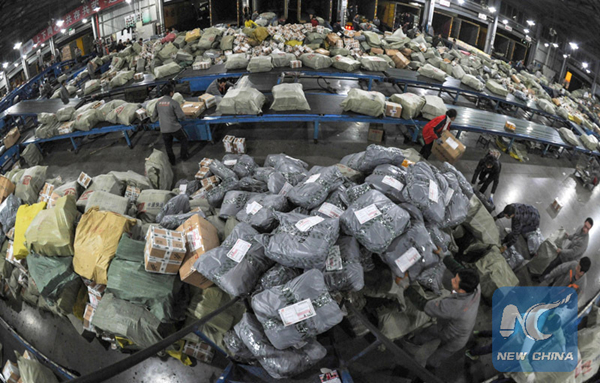Booming E-biz leads to excessive packaging
- By Chen Boyuan
 0 Comment(s)
0 Comment(s) Print
Print E-mail China.org.cn, August 22, 2016
E-mail China.org.cn, August 22, 2016
 |
|
Workers sort out piled-up packages at Shentong Express' sorting center for east China in Xiaoshan District of Hangzhou, capital of east China's Zhejiang Province. [Photo/Xinhua] |
The courier boys travelling through the city streets along with the packages they carry are the face of prospering electronic businesses in China. But the excessive materials, mainly carton boxes and plastics, are becoming an environmental concern at the same time.
The State Post Bureau of China, the agency that supervises the post and courier industries nationwide, recently unveiled a work plan for promoting green packaging that demand progress in using green and recyclable materials, and reducing the size and weight of packaging.
Statistics show that 20.67 billion parcels were delivered across China in 2015, dwarfing all other countries. The figure was 15.75 billion in the first seven months of this year.
Rapid growth based on large business volume is the most noticeable feature of China's courier industry, but the "stunningly excessive use of wrapping material is a problem that comes along with it," said Zhu Lei, from the Beijing Institute of Graphic Communication; he offered consultations to the State Post Bureau's work plan.
The packaging materials used in the courier industry include waybills, envelopes, carton boxes, plastic bags, adhesive tape and buffers. Taking carton boxes and plastic bags for example, they account for 50 percent and 40 percent respectively of the entire business volume in this industry. Also, each parcel takes 0.8 meters of tape, which is a non-degradable material that also causes difficulty in separating the carton boxes and plastic bags.
"The recycle rate for carton boxes and plastic in China's courier industry is less than 10 percent. Instead, most of these materials are directly sent to landfills, causing enormous pressure for an urban environment," said Zhu, noting that developed countries feature higher recycle rates for courier packaging materials.
Apart from waste, unhealthy packaging material is another problem that alerted the country's post authority. Out of cost concern, many courier companies turn to cheaper packaging materials made from chemical or medical wastes, which tend to contain excessive heavy metals, toxic organics and pathogenic viruses.
Zhu hopes that the use of electronic waybills can reach 50 percent this year and reach 90 percent by 2020. He said that the work plan required the national standard for green packaging to be in placed in 2017 and that the phasing-out of hazmat will be completed by 2020.






Go to Forum >>0 Comment(s)